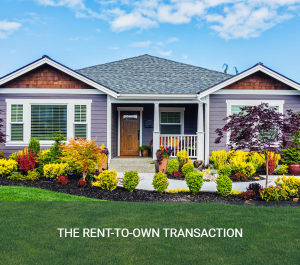
Lease-to-own properties, also known as rent-to-own or lease-option properties, offer tenants the opportunity to eventually purchase the property they are currently renting. Here’s how it generally works for the tenant-potential buyer:
Lease Agreement
The lease agreement is a legally binding contract between the tenant and the landlord that outlines the terms and conditions of renting the property. This includes details such as the monthly rent amount, lease duration, security deposit requirements, rules regarding pets or property use, and responsibilities for maintenance and repairs. The lease term in a lease-to-own arrangement is typically longer than a standard lease to allow the tenant sufficient time to decide whether to purchase the property.
Option Agreement
The option agreement is a separate contract that gives the tenant the exclusive right to purchase the property at a predetermined price within a specified period, usually at the end of the lease term. This agreement typically includes details such as the purchase price, option fee, duration of the option period, and any conditions or terms that must be met for the option to be exercised. The option fee is a non-refundable payment made by the tenant to the landlord to secure the option to buy the property later.
Option Fee
The option fee is an upfront payment made by the tenant to the landlord to secure the option to purchase the property at a later date. This fee is typically non-refundable and is separate from the security deposit or any rent payments. The amount of the option fee is negotiable but is usually around 1-5% of the purchase price of the property. If the tenant decides not to exercise the option to purchase the property, they forfeit the option fee to the landlord.
Rent Payments
During the lease term, the tenant pays rent to the landlord as agreed upon in the lease agreement. However, in a lease-to-own arrangement, a portion of the monthly rent payments may be structured as a “rent credit” or “rent premium.” This means that part of the rent goes towards the eventual purchase of the property. The specific amount of the rent credit is typically outlined in the lease agreement and can vary depending on the terms negotiated between the tenant and landlord.
Maintenance and Repairs
In most lease-to-own agreements, the tenant is responsible for the maintenance and repairs of the property during the lease term. This includes both minor repairs, such as fixing leaky faucets or repairing minor damages, and major repairs, such as replacing appliances or repairing structural issues. The responsibilities for maintenance and repairs are typically outlined in the lease agreement, and the tenant is expected to keep the property in good condition as if they were the owner.
Option to Purchase
At the end of the lease term, the tenant has the option to purchase the property at the predetermined price outlined in the option agreement. This gives the tenant the opportunity to buy the property if they decide they want to make it their permanent home. However, the tenant is not obligated to exercise this option, and they can choose to walk away from the deal if they no longer wish to purchase the property.
Purchase Agreement
If the tenant decides to exercise the option to purchase the property, they enter into a purchase agreement with the landlord. This agreement outlines the terms and conditions of the sale, including the purchase price, closing date, any contingencies, and other relevant details. Both parties must sign the purchase agreement to make the sale legally binding.
Closing Process
The closing process is the final step in purchasing the property and transferring ownership from the landlord to the tenant. During the closing process, the tenant secures financing through a mortgage, which could be provided by Treasury Funds Home Loans, Inc., or other means to complete the purchase, pays any necessary closing costs, and signs all required paperwork. Once all conditions of the purchase agreement have been met, the sale is finalized, and the tenant becomes the official owner of the property.
Overall, lease-to-own arrangements can offer tenants the flexibility to rent a property while also having the option to purchase it in the future. However, it’s essential for tenants to carefully review all agreements and understand their rights and responsibilities before entering into a lease-to-own agreement.
